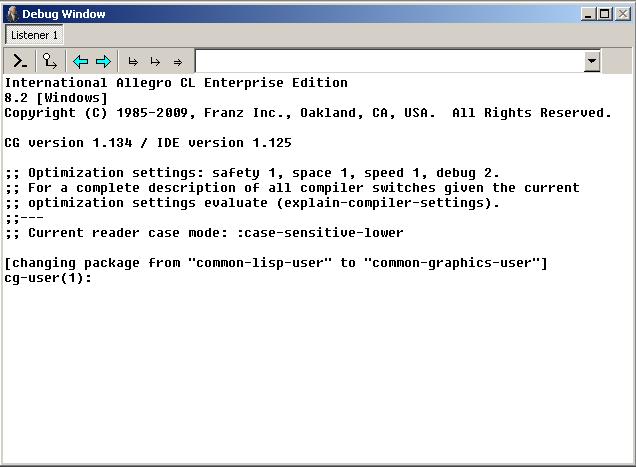
| Allegro CL version 8.2 Moderately revised from 8.1. 8.1 version | ||||||||||
The Debug window contains a listener (with a prompt) where you can enter and evaluate Lisp forms. It also displays debugging information after an error (click here to see the description of the Debug window after an error). Here is the Debug window when there is no error being debugged:

The prompt is a
[current package](Number).
You can type directly to the prompt, pressing Enter
for a newline. If you have entered a complete Lisp expression,
pressing Enter evaluates it and the returned value is printed below
the entered form. If you have not entered a complete expression,
pressing Enter places the cursor on the next line, suitably indented,
waiting for more input.
There are various ways to repeat an already typed expression. One quick way is to place the text cursor anywhere within an expression visible in the listener pane and then press ENTER. This will copy the whole evaluated expression to the end of the listener's text (either to the prompt or after any text already entered at the prompt). You can quickly move the text cursor to various previously-evaluated forms by holding down the Control and Alt keys and pressing the up and down arrow keys (this also works without the Control key, though on Windows that can trigger functionality for inserting special characters that's built into Microsoft widget).
You can also use the history dropping outline to retrieve an already entered expression.
The dropping outline to the right under the title bar displays the history of entered Lisp expressions, with the most recent visible. Both expressions which were evaluated and those which were entered and not evaluated (because, e.g., the New Prompt button was clicked before evaluation) appear in the list. Clicking on an item in this drop-down list will paste the expression at the listener's prompt, ready to be evaluated again (after optionally editing it). Clicking the blue arrow at the left of an expression will show the values that were returned, each in a separate line (expressions not evaluated have a gray dot rather than a blue arrow); clicking one of these values will return the value, leaving the variable * bound to the value for further use. Expressions in the history drop-down list may also be manipulated more quickly with the keyboard shortcuts for some of the buttons to the left of the drop-down list; see below for details.
To instead copy a sub-expression of an earlier evaluation to the prompt, hold down the control key and left-click in or next to the expression. Clicking just before an opening parenthesis or just after the corresponding closing parenthesis will copy a list expression that starts or ends with that parenthesis; similarly, clicking just before an opening double-quote character or just after a closing double-quote character will copy a string; otherwise, clicking anywhere on a "word" (a character sequence demarcated by parentheses, spaces, tabs, and/or newlines) will copy that word (such as a symbol or number).
The buttons to the left of the dropping outline work as follows. (Placing the cursor over a button causes the tooltip to display. We identify the buttons by the tooltip description.)
An additional listener pane can be created by choosing View | New Listener.
Copyright (c) 1998-2016, Franz Inc. Oakland, CA., USA. All rights reserved.
This page has had moderate revisions compared to the 8.1 page.
Created 2016.6.21.
| Allegro CL version 8.2 Moderately revised from 8.1. 8.1 version | ||||||||||